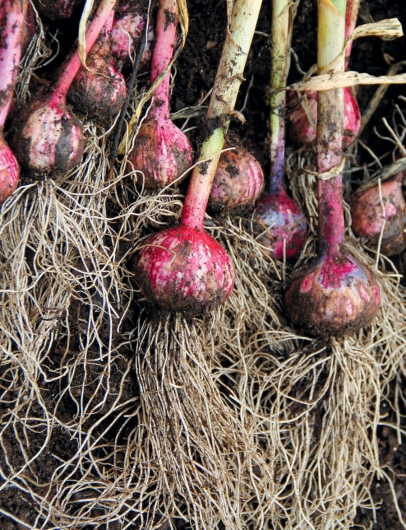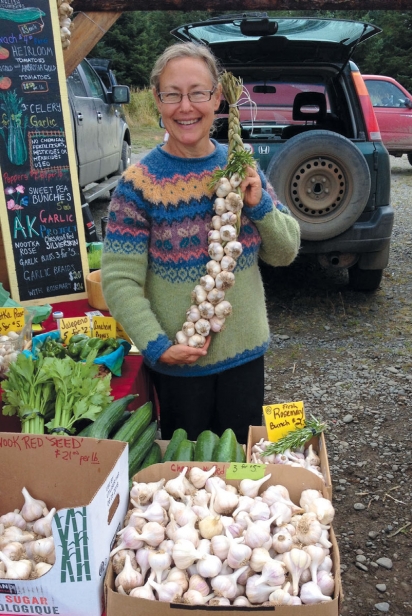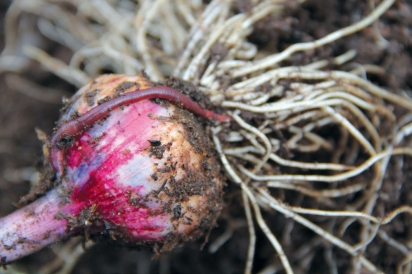Growing Garlic Alaska Style
Have you ever snapped a dry, yet juicy garlic bulb from a garlic braid? The mouthwatering pull brings you home to flavors, smells, and promises of delicious dinners ahead. It’s like harvesting right in your own kitchen.
Nowadays, garlic can be purchased pickled, fermented, powdered, granulated, minced, peeled for you, even crushed for you! However, in my opinion, the absolute best garlics are the bulbs you grow yourself.
ALL GARLIC IS NOT THE SAME
Just as there are different types of apples, carrots, tomatoes, and onions, there are different garlic cultivars. Growing different kinds of garlic is not only rewarding, but it satisfies our human need to experiment. Garlic is available for growers as softneck and hardneck varieties, with many subspecies within these two categories. The garlic you most commonly find in stores is the softneck artichoke variety. Softnecks are good for braiding, they store longer, and size up well in your gardens. Hardneck varieties bring more intense flavors—and provide an edible scape as an added bonus. Some hardneck varieties shine with purple, rich brown and gold skins. I grow both types, as I love to braid garlic, hang it in my kitchen, share with friends, and sell braids at the Homer Farmers Market, with rosemary sprigs included.
OLD TIME ALASKAN GARLIC GROWING
Most old time Alaskan homesteaders learned by trial and error that hardneck garlics performed best and were able to withstand our long harsh winters. Softneck strains had trouble surviving in the freezing ground. So, as Alaskan gardeners got serious, they researched seed catalogues, and began planting hardneck varieties such as Romanian Red, Chesnok Red, Purple Glazer, and Siberian, to name a few. As most gardeners do, they shared their successful cloves with other gardeners. I have found many a gardener who tells me that the garlic strain they love most came from a friend in another part of Alaska, but they cannot name the exact variety. Since I started growing garlic in Homer, I have learned that it takes several years to settle in a strain of garlic and acclimate it to your region. I have also learned that certain softnecks do grow very well here after all, and have found success growing a cultivar called Nootka Rose.
HOW TO GROW GREAT GARLIC IN ALASKA
Garlic is considered a heavy feeder. That means that if you want to grow big bulbs, you need very rich soil, preferably with a pH of 6.5. Once you decide on the variety and strain you will grow, get out your calendar. Garlic needs to be planted in early fall. By planting in late September or very early October you can assure full bulb maturity by the following summer. The goal is to encourage 6 inches of root development before the ground freezes.
Prepare your bed as follows: apply lots of good, rich, finished compost. I apply two 5-gallon buckets of rich, worm-infested compost to a bed that is 30 inches by 10 feet. After forking in the compost, mark off 4 rows spaced at 6 inches apart, allowing for margin space on the edges. Then lightly sprinkle equal parts of Alaska fish bone meal and blood meal right into your furrow. Plant each individual clove, root end down, 8 inches apart in the rows. Be sure to water in your garlic before mulching. Mulch heavily with hay, straw, or seaweed—up to 8 inches thick—as soon as you plant.
In Alaska thick mulch can ensure greater success. Come springtime, as soon as your mulch has thawed, remove it to begin the warming of the soil. Young garlic shoots can withstand freezing temperatures. Start watering when things thaw out and continue to water through June. Garlic can be dug up when the lowest leaves are brown and the stalks begin to fall over, typically in late July. It will store well for many months if cured and dried properly for a few weeks in a dry, warm, well-ventilated area.
After months under your care you will relish the moment you dig fresh garlic from the earth. It is well worth the effort.







